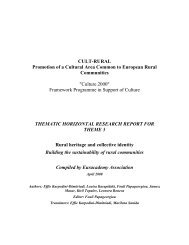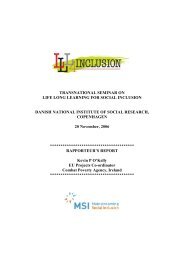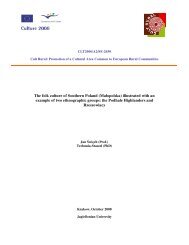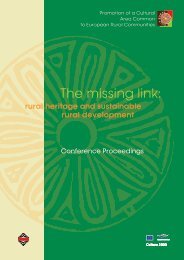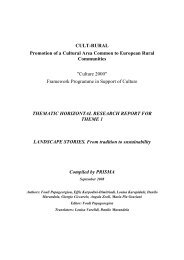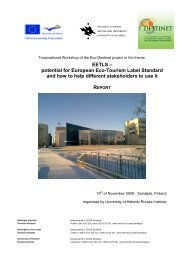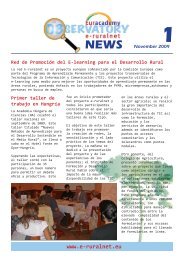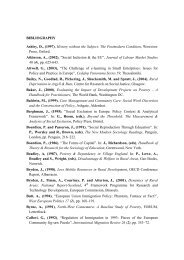ÐÐ¾Ð´Ð°Ñ Ð¿Ð¾ изложбаÑа - cult rural - Prisma
ÐÐ¾Ð´Ð°Ñ Ð¿Ð¾ изложбаÑа - cult rural - Prisma
ÐÐ¾Ð´Ð°Ñ Ð¿Ð¾ изложбаÑа - cult rural - Prisma
You also want an ePaper? Increase the reach of your titles
YUMPU automatically turns print PDFs into web optimized ePapers that Google loves.
THE SCENARIO OF THE EXHIBITION<br />
ECSTATIC RITUALS<br />
Anastenaria or nestinar dance is a representative example of ecstatic rituals<br />
practiced in the Balkans, allegedly of pagan origin. With roots in ancient times,<br />
these rituals have kept alive the memory and bonds of communities which<br />
many generations ago arrived from the Black Sea to Thrace. Barefoot villagers<br />
walk over hot coals on St Constantine and Helen’s day, performing an ecstatic<br />
dance infl uenced by the sound of a specifi c tune. Exhibits include dressed<br />
ikons, as the central item of the ritual, musical instruments (lyra and drum),<br />
sacred kerchiefs (amanetia). A fi lm and slide show with an imposing sound<br />
track takes the visitor through the ritual, from the preparation of the firewalkers<br />
at home to their departure and return for a celebration dinner. Although turned<br />
into a tourist attraction in recent years, the ecstatic abilities of firewalkers that<br />
are inherited or attained after a lengthy preparation and meditation, remain solid<br />
parts of a <strong>rural</strong> tradition that has managed to stay alive.<br />
RITES OF PASSAGE<br />
Rituals celebrating the passage of nature from one season to another and<br />
the passage from adolescence to married life and maturity in the lifecycle of<br />
humans, have always had a special signifi cance, imbued with symbolic acts<br />
and objects. The summer solstice days are celebrated by fires and divinations,<br />
coinciding with St. John the Baptist’s day. Fire symbolizes purification, but<br />
also protection against misfortune, bad luck and illness. Jumping over fires is<br />
illustrated by an allegoric installation. Floating candles on water inside flower<br />
wreaths are exhibited and illustrated in photographs, to convey the message<br />
of the triumph of light over the darkness. Divinations accompany the solstice<br />
celebrations: love fortune-telling, interpretation of dreams and clairvoyance,<br />
all connected to future love and marriage are symbolized by such exhibits as<br />
water urns, keys, dancing and music films and photographs. The wedding<br />
celebrations have their own symbolic objects and parades: a rich bridal<br />
dress with decorated head cover and jewelry, wedding flags, dowry chests<br />
and special foods, including decorated breads, cakes and pomegranates, are<br />
presented around a dancing circle of life-size photographs and a celebration<br />
table with a panorama of foods and various utensils, cutting across all units, to<br />
depict the celebration of utmost joy and hope represented by a wedding.<br />
The thematic organization of the exhibition, based on its narrative character,<br />
allows the visitor to comprehend the symbolic meanings that build the collective<br />
identity of communities through the selective presentation of objects, images<br />
and sounds. Modern works of art complete the structure of the thematic units,<br />
illustrating the modern artists’ interpretation of the symbolic acts and customs<br />
exhibited.<br />
11. Brada (beard) from straw spikes, Bulgaria<br />
12. Bridal bread decorated with fl owers, Anogia,<br />
Crete, Greece<br />
8<br />
11.<br />
12.<br />
13. “Brather-in-law decoration”, eau forte, Y.<br />
Radeva, Bulgaria<br />
14. Carol-singer’s ritual objects, Bulgaria




